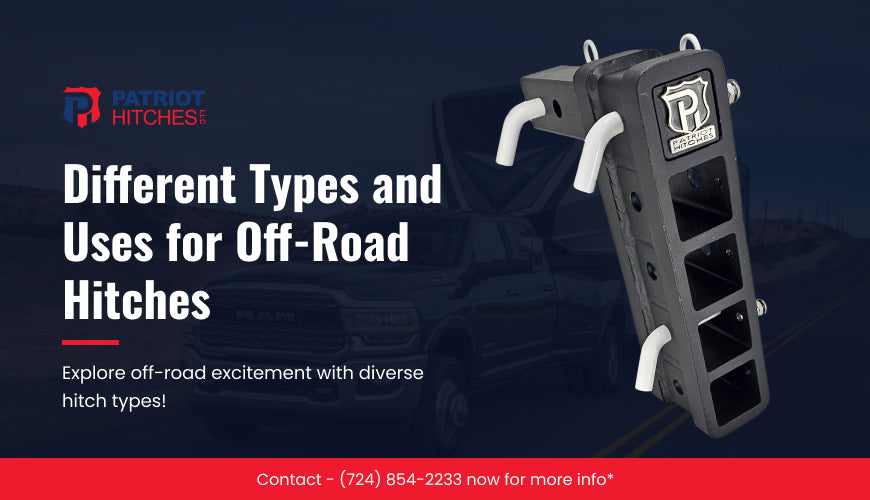Different Types and Uses for Off-Road Hitches
Different Types and Uses for Off-Road Hitches
SCOTT MCCUSKEY @

Off-roading is a thrilling adventure that allows enthusiasts to explore challenging terrains and remote destinations. Whether you're into rock crawling, mudding, or overlanding, having the right equipment is crucial for a successful off-road experience. One such essential accessory is the off-road hitch, a versatile tool that comes in various types, each designed for specific purposes. In this comprehensive guide, we'll delve into the different types and uses for off-road hitches, helping you understand how to choose the right one for your next off-road expedition.
Receiver Hitches: The Backbone of Off-Road Towing
Receiver hitches, recognized as the predominant type, serve as a versatile solution catering to a spectrum of off-road towing requirements. Their widespread use is attributed to their adaptability and compatibility with diverse towing needs. The classification system, based on different classes, serves as a key feature of receiver hitches, signifying their towing capacity.
Class I hitches, the lighter category, find their niche in accommodating smaller trailers. These hitches are particularly suitable for off-roading enthusiasts seeking to traverse less challenging terrains with compact loads, making them ideal for transporting essentials like camping gear or smaller utility trailers.
Conversely, Class IV and V hitches are engineered for heavy-duty off-road towing. Tailored to navigate rugged landscapes, these hitches are indispensable for hauling larger trailers or campers. Their robust construction ensures a secure connection, making them the preferred choice for off-road adventurers tackling more demanding terrains.
Bumper Hitches: The Off-Road Workhorse
Bumper hitches, directly affixed to the vehicle's bumper, provide a robust towing solution tailored for off-road escapades. Primarily designed for recovery operations, winching, and towing in challenging conditions, these hitches offer reliability in demanding terrains. Off-road enthusiasts frequently opt for bumper hitches when a steadfast connection point is essential, appreciating their simplicity and efficiency without the additional complexities associated with receiver hitches. In scenarios where resilience and straightforward functionality are paramount, bumper hitches prove indispensable for a seamless off-road towing experience.
Pintle Hitches: The Heavy-Duty Choice
Pintle hitches are revered for their robust design, rendering them ideal for heavy-duty off-road applications. Widely employed in military and industrial settings, these hitches boast a secure connection and resilience against extreme conditions. Off-road enthusiasts navigating challenging terrains with substantial loads often choose pintle hitches, relying on their durability to withstand the rigors of demanding off-road adventures. In the realm of off-roading, where durability and steadfast connections are paramount, pintle hitches emerge as a preferred choice for those seeking reliability in the face of challenging and unpredictable terrains.
Gooseneck Hitches: Towing with Precision
Gooseneck hitches provide a distinctive towing solution, featuring a ball mounted in the truck bed rather than at the rear. This design enhances stability and maneuverability, proving popular among off-road enthusiasts maneuvering large trailers or equipment through tight spaces. The versatility of gooseneck hitches extends beyond recreational off-roading, finding favor in agricultural and construction settings. Appreciated for their unique design benefits, gooseneck hitches offer a practical and adaptable towing solution, catering to the diverse needs of off-road adventures and industrial applications alike.
Recovery Hitches: Getting Unstuck with Ease
Off-road ventures carry the inherent risk of encountering challenging terrains like mud, sand, or uneven surfaces, often leading to vehicle entrapment. In such scenarios, the pivotal role of recovery hitches, exemplified by snatch straps and tow straps, comes to the forefront. These hitches play a critical role in safely extracting stuck vehicles, ensuring effective off-road recovery. Essential for navigating unpredictable landscapes, a thorough understanding of the proper usage of these recovery hitches is paramount. Off-road enthusiasts must grasp the intricacies of their application to ensure a safe and successful recovery, mitigating the challenges posed by difficult terrains during their adventurous journeys.
Choosing the Right Hitch for Your Off-Road Adventure
Selecting the right off-road hitch depends on various factors, including the type of off-roading activities you enjoy, the weight of the trailers or equipment you plan to tow, and the terrain you'll be traversing. Consider consulting with off-road experts or professionals to determine the most suitable hitch for your specific needs.
Final Thoughts
Off-road hitches are indispensable tools for off-road enthusiasts, providing the means to tow trailers, recover stuck vehicles, and tackle challenging terrains. Understanding the different types and uses of off-road hitches is essential for making informed decisions and ensuring a safe and enjoyable off-road experience. So, before embarking on your next off-road adventure, take the time to choose the right hitch that aligns with your specific needs and enhances your off-roading capabilities.




